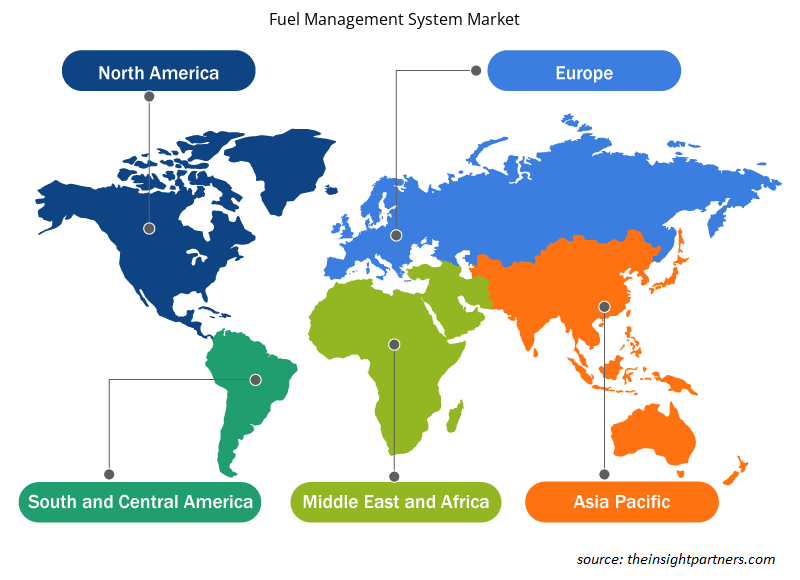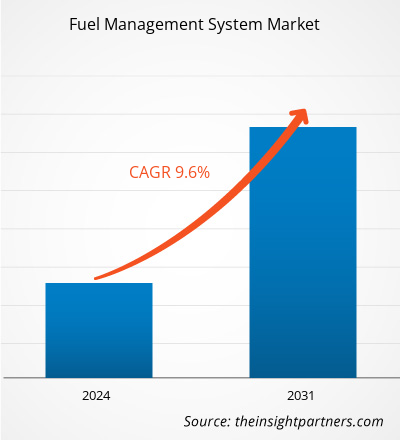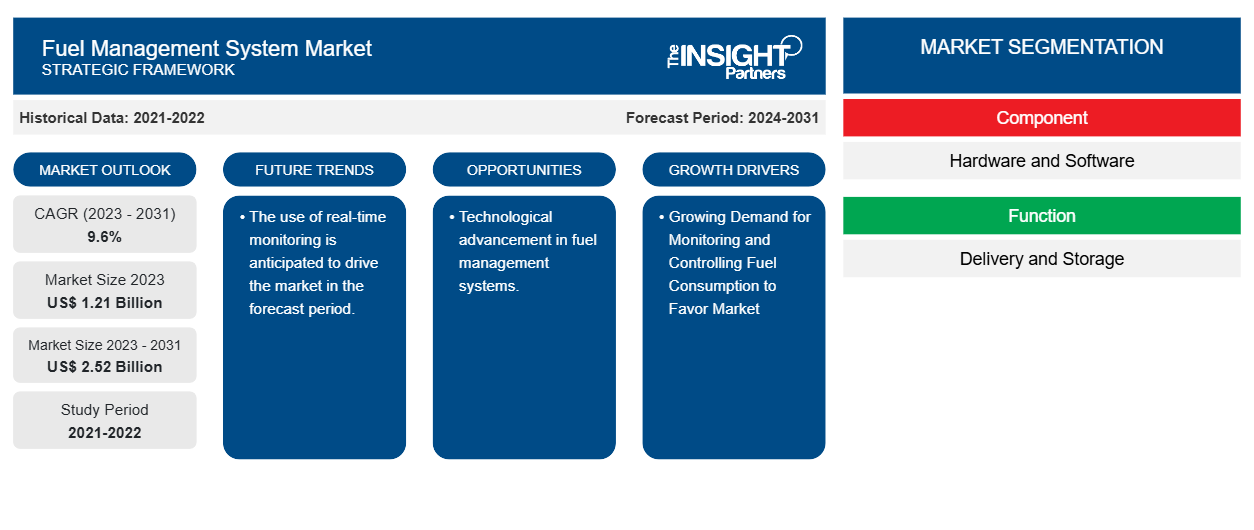燃料管理システムの市場規模は、2023年の12億1,000万米ドルから2031年には25億2,000万米ドルに達すると予測されています。市場は2023年から2031年の間に9.8%のCAGRを記録すると予想されています。燃料消費の監視と制御の需要の増加と燃料盗難の増加は、市場の主要なトレンドであり続けると思われます。
燃料管理システム市場分析
燃料管理システム市場の需要は、複数の業界で生産性と効率性を向上させるためのより優れた燃料管理の必要性が高まるにつれて、拡大すると予想されます。さらに、より良い顧客体験を提供するための電子商取引プラットフォームの急速な成長により、供給および物流業界はIoT産業を強化するようになりました。
燃料管理システム市場の概要
燃料管理システムは、輸送、建設、エネルギー業界などのさまざまなアプリケーションで燃料消費を監視、制御、最適化するために使用されるソフトウェアおよびハードウェア テクノロジの一種です。車両では、燃料管理システムは、燃料消費、エンジン パフォーマンス、およびその他の要因を監視することで、燃料が効率的に使用されていることを確認するのに役立ちます。これにより、燃料コストを削減し、運用効率を高め、排出量を削減できます。
要件に合わせてレポートをカスタマイズする
このレポートの一部、国レベルの分析、Excelデータパックなど、あらゆるレポートを無料でカスタマイズできます。また、スタートアップや大学向けのお得なオファーや割引もご利用いただけます。
-
このレポートの主要な市場動向を入手してください。この無料サンプルには、市場動向から見積もりや予測に至るまでのデータ分析が含まれます。
燃料管理システム市場の推進要因と機会
燃料消費の監視と制御の需要増加が市場を有利にする
燃料消費の監視と制御に対する需要の高まりが、燃料管理システム市場を牽引しています。これは、燃料消費を監視することにはいくつかの利点があるためです。コスト削減、非効率性の特定、排出量の削減などの利点があります。さらに、リアルタイムの燃料消費監視に対する需要も高まっています。これにより、企業は事後ではなく、発生した時点で燃料の無駄を特定して対処できます。これにより、企業は燃料消費とコストをリアルタイムで削減することができ、収益に大きな影響を与えることができます。燃料消費の監視と制御にはいくつかの利点があるため、燃料管理システムは需要があります。
燃料管理システムにおける技術的進歩。
燃料管理システムの技術的進歩には、さまざまなチャンスがあります。IoT統合、予測分析、機械学習アルゴリズム、透明性のためのブロックチェーン、エネルギー効率の高い車両などの技術的進歩は、物流と輸送、製造とサプライ チェーン、農業、建設、車両管理とサービスなど、さまざまな業界に役立ちます。したがって、さまざまな業界での技術的進歩により、燃料管理システムの需要が高まります。
燃料管理システム市場レポートのセグメンテーション分析
燃料管理システム市場分析の導出に貢献した主要なセグメントは、コンポーネント、機能、およびエンドユーザーです。
- コンポーネントに基づいて、燃料管理システム市場はハードウェアとソフトウェアに分かれています。ソフトウェアセグメントは、予測期間中に大きな市場シェアを占めると予想されます。
- 機能に基づいて、燃料管理システム市場は配送と保管に分けられます。配送セグメントは予測期間中に大きな市場シェアを占めると予想されます。
- エンドユーザー別に見ると、市場は鉱業、建設・港湾、輸送・物流、石油・ガス、その他に分類されています。鉱業セグメントは予測期間中に大きな市場シェアを占めると予想されます。
地域別燃料管理システム市場シェア分析
燃料管理システム市場レポートの地理的範囲は、主に北米、アジア太平洋、ヨーロッパ、中東およびアフリカ、南米および中米の 5 つの地域に分かれています。
北米は燃料管理システム市場を支配してきました。北米地域のさまざまな業界でのハイテク採用の傾向が、燃料管理システム市場の成長を後押ししています。デジタルツールの採用の増加や政府機関による多額の技術支出などの要因が、北米の燃料管理システム市場の成長を牽引すると予想されています。さらに、米国とカナダの先進国では研究開発に重点が置かれているため、北米のプレーヤーは技術的に高度なソリューションを市場に投入せざるを得ません。さらに、米国には多くの燃料管理システム市場プレーヤーがおり、革新的なソリューションの開発にますます重点を置いています。これらすべての要因が、この地域の燃料管理システム市場の成長に貢献しています。
燃料管理システム市場の地域別分析
予測期間を通じて燃料管理システム市場に影響を与える地域的な傾向と要因は、Insight Partners のアナリストによって徹底的に説明されています。このセクションでは、北米、ヨーロッパ、アジア太平洋、中東およびアフリカ、南米および中米にわたる燃料管理システム市場のセグメントと地理についても説明します。

- 燃料管理システム市場の地域別データを入手
燃料管理システム市場レポートの範囲
| レポート属性 | 詳細 |
|---|---|
| 2023年の市場規模 | 12億1千万米ドル |
| 2031年までの市場規模 | 25億2千万米ドル |
| 世界のCAGR(2023年~2031年) | 9.6% |
| 履歴データ | 2021-2022 |
| 予測期間 | 2024-2031 |
| 対象セグメント |
コンポーネント別
|
| 対象地域と国 |
北米
|
| 市場リーダーと主要企業プロフィール |
|
市場プレーヤーの密度:ビジネスダイナミクスへの影響を理解する
燃料管理システム市場は、消費者の嗜好の変化、技術の進歩、製品の利点に対する認識の高まりなどの要因により、エンドユーザーの需要が高まり、急速に成長しています。需要が高まるにつれて、企業は提供を拡大し、消費者のニーズを満たすために革新し、新たなトレンドを活用し、市場の成長をさらに促進しています。
市場プレーヤー密度とは、特定の市場または業界内で活動している企業または会社の分布を指します。これは、特定の市場スペースに、その規模または総市場価値と比較して、どれだけの競合相手 (市場プレーヤー) が存在するかを示します。
燃料管理システム市場で事業を展開している主要企業は次のとおりです。
- シェビン フリート ソリューション
- フランクリンエレクトリック
- ギルバルコ株式会社
- マルチフォースシステムズ株式会社。
- ナビ8
- ピウジ SpA
免責事項:上記の企業は、特定の順序でランク付けされていません。

- 燃料管理システム市場のトップキープレーヤーの概要を入手
燃料管理システム市場のニュースと最近の動向
燃料管理システム市場は、主要な企業出版物、協会データ、データベースなどの一次調査と二次調査後の定性的および定量的データを収集することによって評価されます。燃料管理システム市場におけるいくつかの開発を以下に示します。
- Kongsberg Digital と Royston は提携して電子燃料管理システムを提供しています。この提携により、船主は Kongsberg Digital の Vessel Insight と Royston の電子燃料管理システムである Enginei を組み合わせることで、燃料消費を最適化し、透明性を高め、船舶運航の脱炭素化を促進できるようになります。(出典: Royston、プレス カンパニー ウェブサイト、2024 年 2 月)
- エアバスは、持続可能な航空燃料(SAF)の新興リーダーであるDG Fuels, LLC(「DGF」)と戦略的パートナーになりました。DGFの燃料生産システムは、伐採産業からの木材廃棄物などのセルロース廃棄物と、風力や太陽光発電などの再生可能エネルギー源のみに基づいています。(出典:エアバス社ウェブサイト、2023年9月)
燃料管理システム市場レポートの対象範囲と成果物
「燃料管理システム市場規模と予測(2021〜2031年)」レポートでは、以下の分野をカバーする市場の詳細な分析を提供しています。
- 対象範囲に含まれるすべての主要市場セグメントについて、世界、地域、国レベルでの燃料管理システム市場規模と予測。
- 燃料管理システム市場の動向、および推進要因、制約、主要な機会などの市場動向。
- 詳細なPEST/ポーターの5つの力とSWOT分析
- 主要な市場動向、世界および地域の枠組み、主要プレーヤー、規制、最近の市場動向を網羅した燃料管理システム市場分析。
- 市場集中、ヒートマップ分析、主要プレーヤー、燃料管理システム市場の最近の動向を網羅した業界の状況と競争分析。
- 詳細な企業プロフィール。
- 過去2年間の分析、基準年、CAGRによる予測(7年間)
- PEST分析とSWOT分析
- 市場規模価値/数量 - 世界、地域、国
- 業界と競争環境
- Excel データセット
最新レポート
関連レポート
お客様の声
購入理由
- 情報に基づいた意思決定
- 市場動向の理解
- 競合分析
- 顧客インサイト
- 市場予測
- リスク軽減
- 戦略計画
- 投資の正当性
- 新興市場の特定
- マーケティング戦略の強化
- 業務効率の向上
- 規制動向への対応























 無料サンプルを入手 - 燃料管理システム市場
無料サンプルを入手 - 燃料管理システム市場